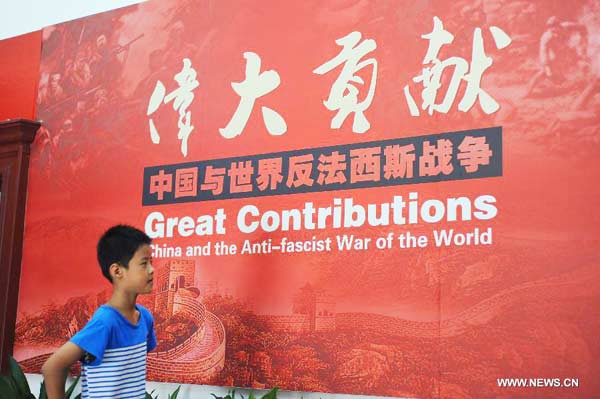China a forgotten WWII ally: historian
(Xinhua) Updated: 2015-08-05 20:07
BEIJING - China deserves more respect abroad for its role resisting fascism during World War II, a Chinese historian has said, as the country marks the 70th anniversary of the end of the war.
"China's important status and efforts during the war have been neglected by the West for more than 70 years due to the cold war. It's not fair that the country hasn't received due respect and has become a forgotten ally," Hu Dekun wrote in an article published on Wednesday in Guangming Daily.
Hu, president of the Chinese Research Association of Second World War History, stressed that China was the main battlefield in Asia and one of the most important battlefields in the whole of the war.
Japan started to invade northeast China in September 1931, foreshadowing WWII and making China the first country to resist Fascism. With Japan's full-scale invasion kicking off on July 7, 1937, the Kuomintang and the Communist Party of China (CPC) joined forces, making China the first battlefield of resistance against the Axis.
Citing Japanese battle logs describing the bloody Battle of Songhu in 1937, Hu said Chinese soldiers and civilians' resistance was "very tough." They endured a siege during the battle in which Japan suffered more than 40,000 casualties.
China's resoluteness foiled the enemy's fantasy of winning the war within a month and dragged the main force of the Japanese army into drawn-out, costly warfare, holding Japan back from invading other regions and relieving pressures on the United States, Britain and the Soviet Union.
According to the article, as Japan had to gradually mobilize more forces to China, 32 of 34 divisions of the Japanese army, or 94 percent of its entire forces, as well as some navy forces, ended up in the China battlefield by 1938, when large-scale battles took place in central China.
As the resistance went on, the CPC's regular army and militia grew to surpass 3.1 million people and they became the main force to finally turn the tables and launch counterattacks in 1945.
Meanwhile, China's fierce resistance also greatly distracted Japan from the Pacific battlefield, Hu noted.
In 1942, the Japanese navy mapped a plan to invade Australia to prevent the United States using the country as a base to launch counterattacks, but the Japanese army, unable to transfer a huge portion of its forces from China, rejected the plan.
- Kunming holds exhibition featuring victory in World War II
- Exhibition to mark victory in World War II
- Secret World War II documents show partnership in action
- Bulk World War II artillery shells found in NE China farmer's house
- Concert commemorating World War II victory held in Sichuan
- Poland commemorates 70th anniversary of end of World War II
- World War II memorial cemetery in Cairo
- China plans longer weekends to boost tourism, consumption
- Chinese airlines score poorly
- Ex-SOE executive gets 18-year prison sentence
- Rainfall and hot weather blamed as algae hits major lakes
- Private entities allowed to build, manage public parking lots
- Fund to combat AIDS open for applications
- Govt encourages people to work 4.5 days a week
- Action to be taken as HIV cases among students rise
- Debate grows over reproductive rights
- Country's first bishop ordained in 3 years








